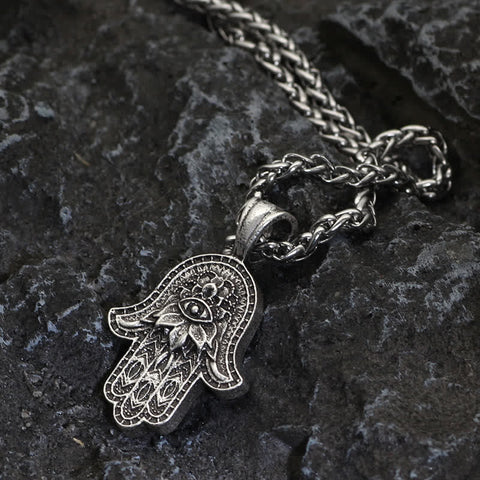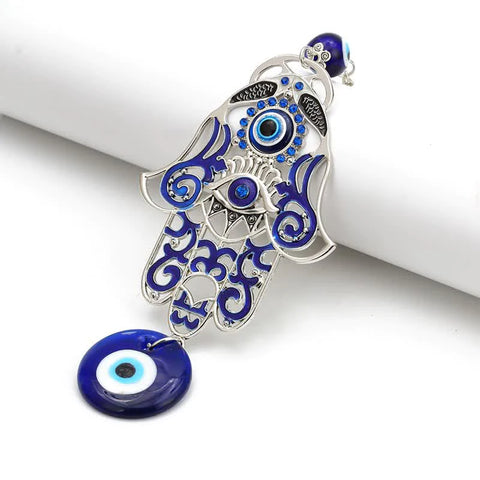The Hamsa: The All-Seeing Hand of Protection and Blessings
This passage will guide you at:
-
Introduction
-
Origins of the Hamsa: A Symbol with Ancient Roots
-
The Hamsa's Meaning: Protection and Blessings Unveiled
-
The All-Seeing Hand: A Powerful Talisman Across Cultures
-
The Hamsa in Buddhism: An Integration of Beliefs
-
Choosing the Right Hamsa: Variations and Symbolism Explored
-
Embracing the Hamsa: Invoking Positive Energies in Daily Life
Introduction
The Hamsa, also known as the Hand of Fatima or Hand of Miriam, is a captivating symbol with a rich history and profound significance. Its presence can be found in various cultures and religions, each offering their interpretation of its meaning and power. In this blog, we delve into the origins of the Hamsa, explore its symbolism across different belief systems, and discover how it can be embraced as a source of protection and blessings in our daily lives.
Origins of the Hamsa: A Symbol with Ancient Roots
The Hamsa's origins can be traced back to ancient Mesopotamia, where it was believed to represent the hand of the supreme god. Over time, the symbol migrated to different regions, including North Africa, the Middle East, and Mediterranean cultures, each infusing it with their own unique interpretations. Its widespread adoption demonstrates the enduring appeal and universal resonance of the Hamsa.
The Hamsa's Meaning: Protection and Blessings Unveiled
Central to the Hamsa's symbolism is its association with protection against the evil eye, a belief shared by various cultures. The hand-shaped talisman is thought to ward off negative energies, providing a shield of defense for those who possess it. Additionally, the Hamsa is seen as a bringer of blessings, representing abundance, prosperity, and good fortune. By embracing the Hamsa, individuals seek to invite positivity into their lives while safeguarding themselves from harm.
The All-Seeing Hand: A Powerful Talisman Across Cultures
One of the most intriguing aspects of the Hamsa is its all-seeing nature. The eye depicted in the center of the palm symbolizes divine watchfulness, omniscience, and spiritual awareness. This concept resonates across multiple cultures, from the Eye of Horus in ancient Egypt to the Third Eye in Hinduism and Buddhism. The Hamsa's all-seeing hand serves as a constant reminder to stay mindful and connected to the spiritual realm.
The Hamsa in Buddhism: An Integration of Beliefs
In Buddhism, the Hamsa merges with the concept of the Dharma Wheel, representing the teachings of Buddha and the path to enlightenment. This amalgamation showcases the harmonious blending of symbols and beliefs, emphasizing the interconnectedness of different spiritual traditions. Buddhists often embrace the Hamsa as a protective amulet, uniting the power of compassion and wisdom in their spiritual journey.
Choosing the Right Hamsa: Variations and Symbolism Explored
The Hamsa is available in a myriad of designs, allowing individuals to select a variation that resonates with them on a personal level. From intricate silver pendants to vibrant ceramic wall hangings, each Hamsa carries its unique symbolism and aesthetic appeal. Understanding the different elements, such as color, materials, and additional motifs, can guide the selection process, ensuring the chosen Hamsa aligns with one's intentions and preferences.
Embracing the Hamsa: Invoking Positive Energies in Daily Life
Beyond being a decorative piece, the Hamsa holds the potential to enhance one's daily life. Incorporating the Hamsa into home decor, workspace, or personal accessories serves as a constant reminder of its protective and blessing properties. Placing a Hamsa near entrances or in areas where negative energy may accumulate is believed to create a barrier against harm. Meditating or focusing on the Hamsa can help cultivate a sense of inner peace and mindfulness, amplifying its positive influence. By integrating the Hamsa into daily life, individuals can harness its transformative energy and experience its profound benefits.
Conclusion
The Hamsa is a captivating symbol of protection and blessings that transcends cultural and religious boundaries. Its origins date back to ancient times, and its all-seeing hand represents spiritual awareness and divine watchfulness. By embracing the Hamsa in our daily lives, we invite its positive energies and safeguarding influences. Whether it is through wearing Hamsa jewelry, incorporating it into home decor, or simply reflecting on its symbolism, the Hamsa serves as a powerful reminder to stay mindful and connected to the spiritual realm. May the Hamsa guide and bless us on our journey, providing us with the protection and abundance we seek.










